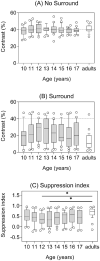Perceptual Center-Surround Contrast Suppression in Adolescence
- PMID: 37200040
- PMCID: PMC10207957
- DOI: 10.1167/iovs.64.5.14
Perceptual Center-Surround Contrast Suppression in Adolescence
Abstract
Purpose: Center-surround contrast suppression-typically induced when a center pattern is surrounded by another pattern with similar spatial features-is considered a perceptual analogue of center-surround neurophysiology in the visual system. Surround suppression strength is altered in a range of brain conditions affecting young people (e.g., schizophrenia, depression, migraine) and is modulated by various neurotransmitters. The early teen years are associated with neurotransmitter changes in the human visual cortex, which could impact on excitation-inhibition balance and center-surround antagonistic effects. Hence, we predict that early adolescence is associated with perceptual changes in center-surround suppression.
Methods: In this cross-sectional study, we tested 196 students at every age from 10 to 17 years and 30 adults (aged 21-34 years) to capture the preteen, adolescent, and adult periods. Contrast discrimination thresholds were measured for a central, circular, vertical sinusoidal grating pattern (0.67° radius, 2 cyc/deg spatial frequency, 2 deg/s drift rate) with and without the surround (4° radius, otherwise same spatial properties as the center). Individual suppression strength was determined by comparing the perceived contrast of the target with and without the surround.
Results: After excluding unreliable data (7% of total), we found an effect of age on perceptual center-surround contrast suppression strength, F(8,201) = 2.30, P = 0.02, with weaker suppression in the youngest adolescents relative to adults (Bonferroni pairwise comparisons between adults vs 12-year-olds P = 0.01; adults vs 13-year-olds P = 0.002).
Conclusions: Our data demonstrate different center-surround interactions in the visual system-a key building block for visual perception-in early adolescence relative to adulthood.
Conflict of interest statement
Disclosure:
Figures






Similar articles
-
Migraine increases centre-surround suppression for drifting visual stimuli.PLoS One. 2011 Apr 11;6(4):e18211. doi: 10.1371/journal.pone.0018211. PLoS One. 2011. PMID: 21494594 Free PMC article.
-
Acute caffeine ingestion affects surround suppression of perceived contrast.J Psychopharmacol. 2018 Jan;32(1):81-88. doi: 10.1177/0269881117725684. Epub 2017 Sep 7. J Psychopharmacol. 2018. PMID: 28879800
-
Spatial frequency bandwidth of surround suppression tuning curves.J Vis. 2012 Jun 19;12(6):10.1167/12.6.24 24. doi: 10.1167/12.6.24. J Vis. 2012. PMID: 22715195 Free PMC article.
-
Surround suppression supports second-order feature encoding by macaque V1 and V2 neurons.Vision Res. 2014 Nov;104:24-35. doi: 10.1016/j.visres.2014.10.004. Epub 2014 Oct 23. Vision Res. 2014. PMID: 25449336 Free PMC article. Review.
-
Functional architecture of long-range perceptual interactions.Spat Vis. 1999;12(2):143-62. doi: 10.1163/156856899x00094. Spat Vis. 1999. PMID: 10221425 Review.
Cited by
-
Alterations in center-surround contrast suppression in patients with major depressive disorder.Sci Rep. 2024 Nov 15;14(1):28160. doi: 10.1038/s41598-024-78584-z. Sci Rep. 2024. PMID: 39548175 Free PMC article.
-
Visual surround suppression at the neural and perceptual levels.Cogn Neurodyn. 2024 Apr;18(2):741-756. doi: 10.1007/s11571-023-10027-3. Epub 2023 Nov 28. Cogn Neurodyn. 2024. PMID: 38699623 Free PMC article. Review.
-
Altered Outer Retinal Structure, Electrophysiology and Visual Perception in Parkinson's Disease.J Parkinsons Dis. 2024;14(1):167-180. doi: 10.3233/JPD-230293. J Parkinsons Dis. 2024. PMID: 38189711 Free PMC article.
References
-
- Braddick O, Atkinson J.. Development of human visual function. Vision Res. 2011; 51: 1588–1609. - PubMed
-
- Leat SJ, Yadav NK, Irving EL.. Development of visual acuity and contrast sensitivity in children. J Optom. 2009; 2: 19–26.
-
- Stiers P, Vanderkelen R, Vandenbussche E.. Optotype and grating visual acuity in preschool children. Invest Ophthalmol Vis Sci. 2003; 44: 4123–4130. - PubMed
-
- Mayer DL, Dobson V.. Visual acuity development in infants and young children, as assessed by operant preferential looking. Vision Res. 1982; 22: 1141–1151. - PubMed
-
- Birch EE, Gwiazda J, Bauer JA Jr., Naegele J, Held R. Visual acuity and its meridional variations in children aged 7-60 months. Vision Res. 1983; 23: 1019–1024. - PubMed
Publication types
MeSH terms
Substances
LinkOut - more resources
Full Text Sources
Miscellaneous

